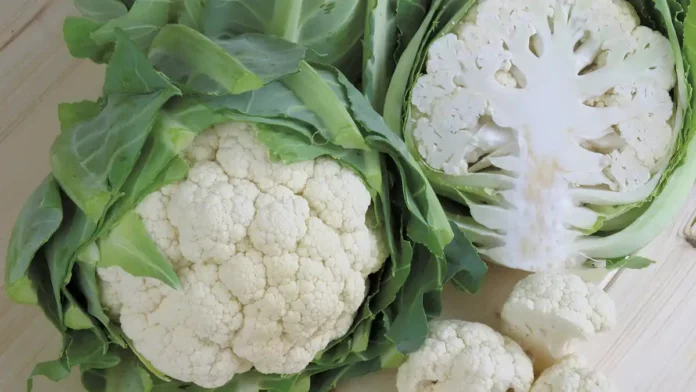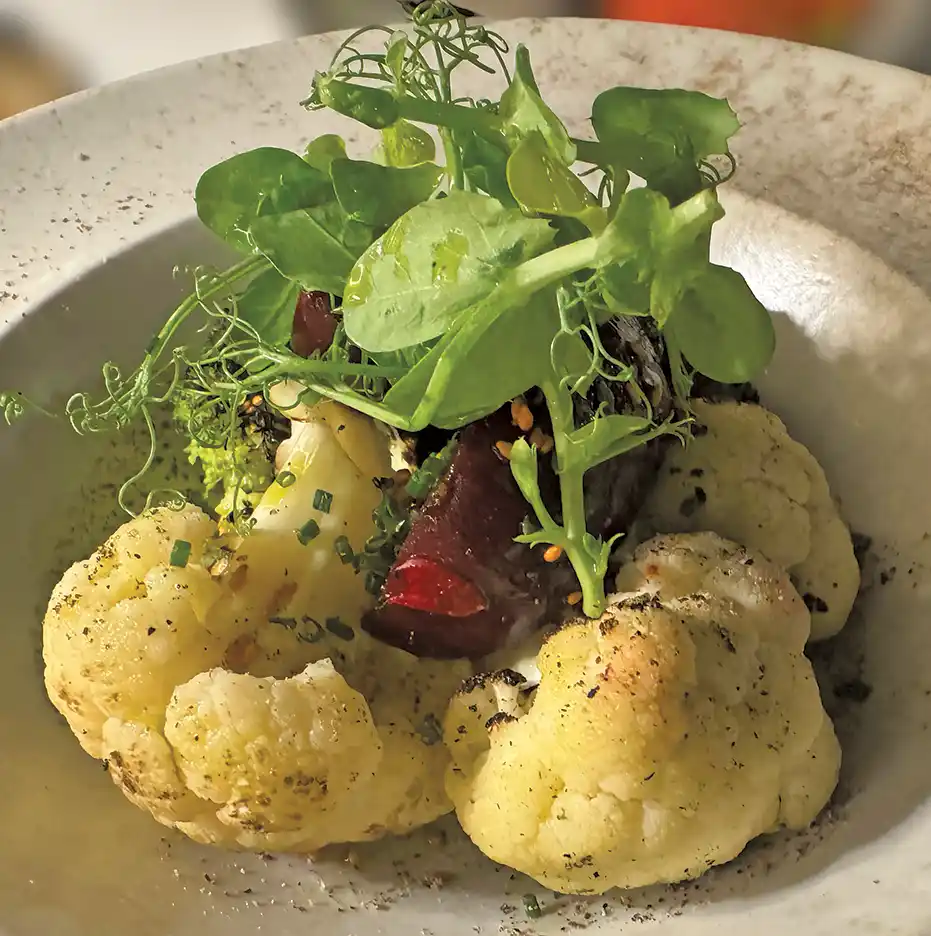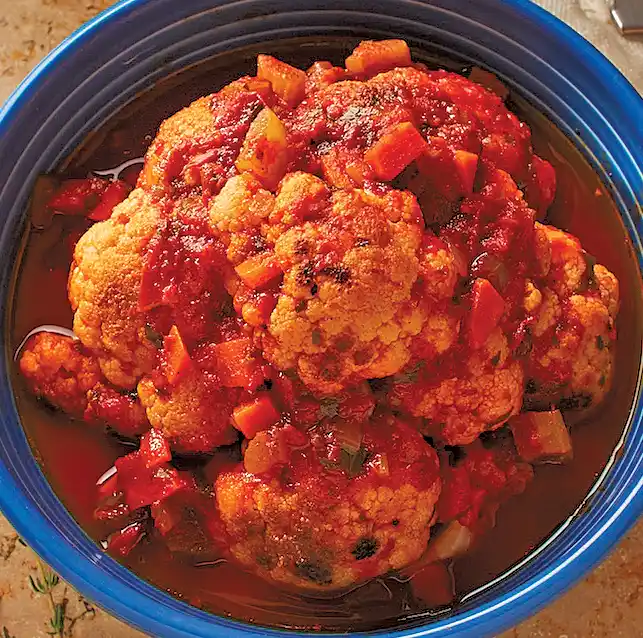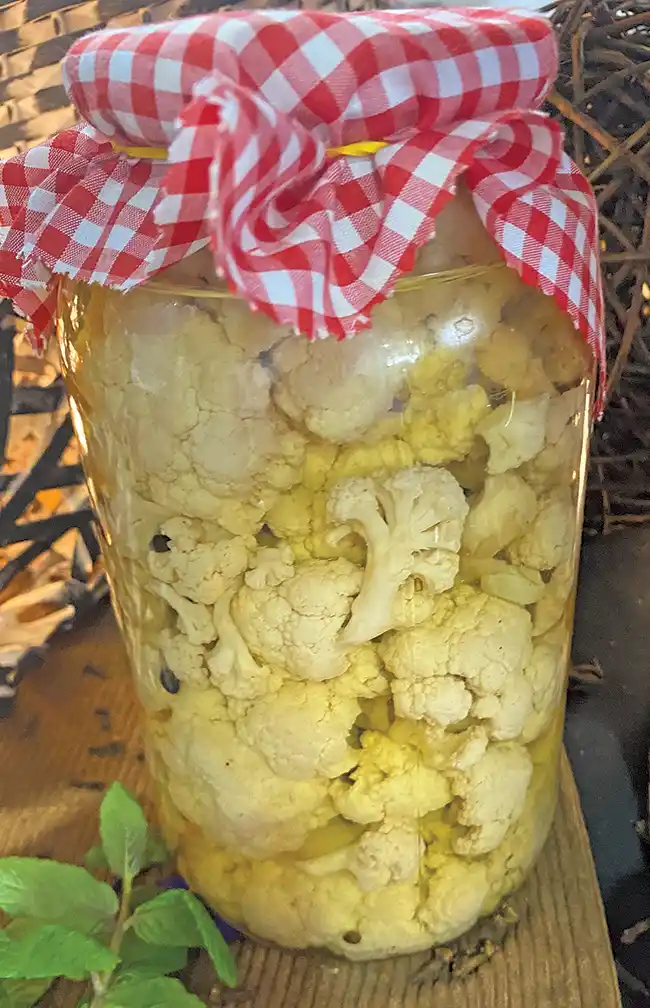
As we sit right on the precipice of spring, we’re teased by still cool weather, with the promise of life renewed – the trees begin to bud, the air feels fresher, and the excited anticipation of greenery and warmth pervades.
Within all of this springtime fervor, changes are happening elsewhere – in particular, the seasonal produce available at farmers markets, grocery stores, and distributors… the winter roots are fading into the background, and the early spring stars are making their first appearances… and who been one of the biggest stars on the culinary scene in recent years than cauliflower?!
Table of Contents
Humble Roots…
Multiple millennia ago, the humble Brassica oleracea, the ancient wild mustard plant, grew across the Mediterranean and parts of Europe.
Over time, humans selectively bred this plant for different qualities – some for more leaves, some for more stems, some for more buds, some for more flowers, or a combination of any of the above…
Over time and through natural selective breeding and fortunate mutations, a whole group of delectable cruciferous vegetables came about – mustard greens, collard greens, and kale (bred for more leaves), kohlrabi (bred for more stems), cabbage and brussels sprouts (bred for more buds), cauliflower (bred for more flowers), and broccoli (bred for a combination of flowers and stems).
It is believed that cauliflower, as it is known today, first originated in Cyprus somewhere between the 12th and 14th centuries; however, in his book Natural History (1st century AD), Pliny the Elder refers to a flowering variety of cabbage, known as cyma, as the tastiest of all the cabbages.
From Cyprus, modern day cauliflower spread to Italy in the late 15th century, and from there all over Europe and the world.
It is worth noting that wild variants of the Brassica genus existed in other parts of the world that evolved and were domesticated over time – in particular in Asia.

…Secretly Famous
Though cauliflower has been around and part of the world’s general vegetable repertoire for hundreds of years, in the days of yore and yesteryear, it was mostly served plain and boiled, often left on the plate instead of consumed.
It wasn’t until recent years where suddenly it seemed like cauliflower was EVERYWHERE. From cauliflower steaks, to cauliflower pizza crusts, to cauliflower rice, it seemed nothing was spared from the infiltration of the world’s most unassuming vegetable.
But, before we get into the astonishing versatility of the incredible edible cauliflower, let’s talk about the different kinds and why this vegetable was born for stardom.
A Bouquet of Cauli-Flowers
Of course, there’s the unassuming, traditional cauliflower variety, with its pristine white florets, but are you familiar with the gorgeous array of colors and unique shapes this delightful vegetable comes in?
There’s the vivid purple cauliflower, which has the same phytochemicals that make red cabbage and red onions purple. There’s also the bright orange cauliflower, which boasts a healthy dose of beta-carotene, much like in carrots, that allows for its dazzling hue.
And then there’s green cauliflower, and it’s very unique cousin, Romanesco. While both green cauliflower and Romanesco share coloring thanks to additional chlorophyl, Romanesco has a naturally occurring fractal pattern, lending them their trademark distinction and appeal.
Each head of Romanesco is made up of smaller buds that build over and over each other, resulting in Romanesco’s recognizable peaks, which is also why this flower never blooms.
A mutation in their genetics causes the plant to keep repeating its budded pattern without fully blooming, thereby creating its shape.
The Healthiest Flower
While purple cauliflower is the healthiest of the varieties available due to the additional antioxidants that provide for its gorgeous violet hue, all types of cauliflower are incredibly good for you!
Cauliflower of all kinds are an excellent source of vitamins and minerals, including vitamin C, folate, and vitamin K, while orange cauliflower has the added bonus of being chockful of vitamin A as well.
It’s also full of antioxidants, which are beneficial for reducing inflammation and protecting against several chronic diseases, as well as slowing down the aging process on a cellular level.
Cauliflower is also full of fiber, high in water content, and low in calories, which is a great combination to aid in weight loss while maintaining feelings of fullness and a healthy digestive system.
But remember, before changing or adding anything to your diet, always ask your doctor.

Not Everyone Loves Cauliflower
Though I love it now, as a child I despised cauliflower. Much of the time, my mother would prepare it by simply steaming or boiling it, sometimes with lemon, sometimes without – and I would refuse to eat it.
But, when my Yiayia (grandmother in Greek) made her kounoupidi kokkinisto (red cauliflower), I would gobble it up! She cut up onions, carrots, and celery (sometimes adding garlic too), and sauteed them until they wilted, then added a healthy dose of tomato paste, and allowed them to caramelize.
She’d add some water, season it properly, bring it to a boil, and then turn off the heat. Once the heat was off, she would add the cauliflower florets and allow them to steep in the tomato-y sauce until they were tender-crisp and had absorbed the delicious flavor of her perfectly balanced sauce.
She would finish it with a squeeze of lemon and serve it with some Feta cheese and fresh bread. Though I loved the slight crunch her kounoupidi kokkinisto had, what I really waited for was when it got softer (the longer it steeped) and I could almost spread it on a piece of bread, along with the sauce, top it with Feta, and make a little sandwich out of it!
It was sweet, and unctuous – like being hugged on the inside.
My Papou (grandfather in Greek) always told us to eat our cauliflower, but never forced us. He said, “it’s very good for you, but if you don’t like it, don’t eat it…but one day, when you’re older, you’ll love it – mark my words.”
He also told us that his young appearance was thanks to cauliflower – which he was right about, as always!
A Cauli-Flower for Every Occasion
In 2024, it’s virtually impossible to find a menu without cauliflower on it. We’re now in the second decade of the reign of cauliflower, and it’s not hard to understand why.
Cauliflower is unbelievably versatile, if for no other reason than its ability to shapeshift and take on the flavors of whatever it’s prepared with; it also adjusts accordingly to how it’s prepared – it is, perhaps, the ultimate culinary chameleon.
Beyond its flexibility, cauliflower is also an highly cost-effective ingredient to have on-hand and on menus.
We’re all familiar by now with cauliflower steaks, but it never ceases to amaze that this beautiful vegetable has such a wonderful mouthfeel, that it can replace meat for a meal without skipping a beat.
Try seasoning or marinating an entire head of cauliflower, and then roasting it or smoking it – the diverse textures will blow your mind, and depending on what you use to flavor it, will amend the surface textures in conjunction.
Think about a marinade with more sugars involved, like a barbecue glaze or Korean style gojuchang marinade – even simply using tomato paste – the sticky caramelization of the surface will be astounding, while the florets will gradually get softer, until you hit the core, which will then be perfectly tender-crisp.
If you choose to go the simple route, rubbing the head with olive oil and seasoning liberally with salt, pepper, oregano, and lemon the surface with brown perfectly with each tiny bud bursting with that beautiful, roasted flavor.

How about a luscious, creamy vegan cauliflower and leek soup, with hints of roasted garlic and the gentle perk of lemon zest? Or a decadent cauliflower mash with milk and yogurt, infused with fresh herbs to accompany a gorgeous roasted spatchcock chicken with pan jus?
Have you considered stewing or steeping cauliflower in a rich, hearty sauce?
Think of something in the Southeast Asian style, like a Thai-style cauliflower curry, with rich coconut milk, sweet peppery heat, and a bright lime kick; or a deeply flavored Indian-style curry, perhaps with garam masala to bring out the sweetness of the cauliflower itself, alongside the warming spices.
Let’s not forget the simple roasted cauliflower, tossed in olive oil, seasoned with salt and pepper – of course you can add an array of spices like turmeric, za’atar, mustard, or a curry mix, but it’s unnecessary – the surface caramelization of the florets when roasted at high heat brings the modest seasoning to new heights, sure to delight diners every time.
Riced cauliflower can substitute for rice on a plate, but have you considered roasting the cauli-rice for a healthy, crunchy-textured garnish for dishes…like that cauliflower soup mentioned before…
Cauliflower is also an amazing alternative for gluten-free diners – though much more crisp than a traditional pizza or flatbread, there’s something about the softness that the cauliflower offers that makes it so much more satisfying than traditional gluten-free bread alternatives.
Oh, and don’t forget about eating it raw! The crunchy texture and haphazard surface area of the florets make it the perfect vehicle for serving with your favorite dips – both hot and cold.
It also makes a wonderful addition to salads, adding a similar textural crunch to cucumber or raw bell pepper, but reflecting the other flavors in the salad like a delectable epicurean mirror.
Kounoupidi in the [Greek] Kouzina (Cauliflower in the Greek Kitchen)
While I’ve talked a lot about the different things you can do with cauliflower in the kitchen, in Greece, we like to keep things simple – and delicious!
Taking note from my grandmother’s wisdom, I find tomato paste to be the perfect complement to cauliflower, like my favorite Kyknos.
The unctuous, umami quality of tomato paste pairs perfectly with the subtle earthiness of cauliflower, and when cooked together – whether sauteed, roasted, braised, steeped, baked, or stewed – brings out this slightly sweet, comforting flavor that nothing else can achieve.
As we Greeks cannot live with olive oil, lemon, and oregano, these are the ideal complement for this cruciferous flower as well, and bring out the best no matter the preparation.
Bright, briny flavors like olives and capers shine with cauliflower as the canvas, and the sharpness of Feta is always welcome alongside any – and every meal.
Of course, we turn that on its heels, and pickle cauliflower for toursi (pickles) – an amazing Lenten snack (alongside other pickled vegetables).
I could go on and on about cauliflower, like so many of us have for so many years, but the truth is, there’s no need to!
Cauliflower is the quintessential vegetable, and perfect ingredient for any kitchen – it’s tasty, healthy, and easy to prepare – what’s not to love about this magical mutant?!
All photo credits are Chef Loi























